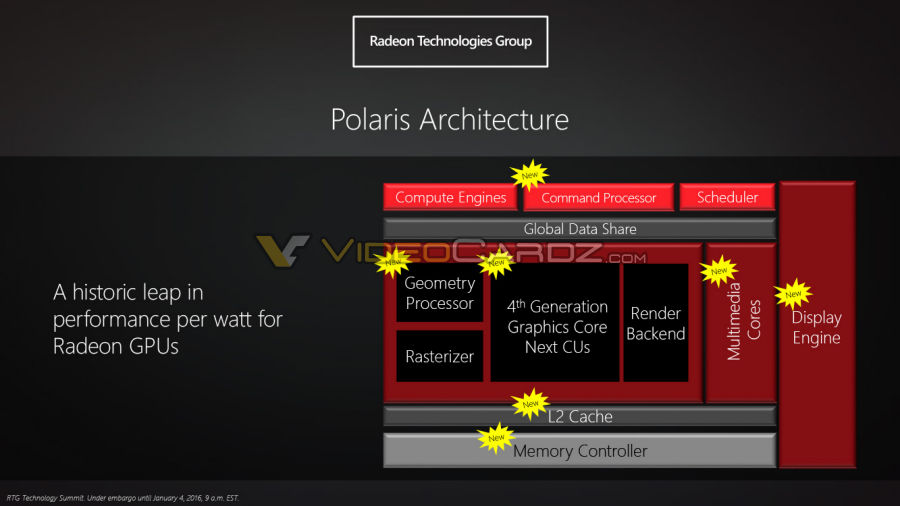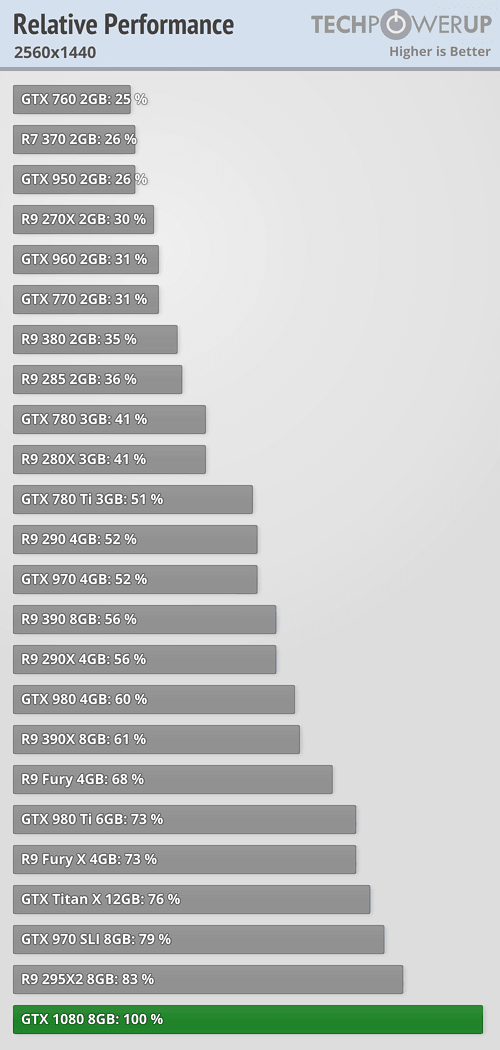GTX 1080 is averaging 50% over Fury Air. People are guessing Polaris 10 to be anywhere from 390 to faster than Fury X based on their level of optimism, so matching Fury Air would be middle of the road with the expectations.
1080 is not 50% faster than Fury X. A max overclocked 1080 is.
1080 is
26% and 33% faster (max power target) than Fury X @ 4K per Computerbase.
1080 is
33.3% faster than Fury X @ 4K per TPU.
1080 is
33.3% faster than Fury X @ 4K per Sweclockers.
1080 is
28% faster than Fury X @ 4K per TechSpot.
Nowhere close to 50% faster unless you meant 1080 max OC vs. a stock Fury X.
Right, so there's literally nothing known about Vega's die size. Just guesswork.
It would be odd to have a 315mm2 Vega with 700GB/sec+ HBM2 but Polaris 10 230mm2 with 256-bit bus and only 7Gbps 224GB/sec bandwidth. You can connect the dots on this one that there are either 2 Vega chips (1x HBM2 and 1x GDDR5X) or if Vega is a cut-down part, at least one of the Vega chips should have a die larger than GP104's.
Remember $400 R9 290 and $550 290 X vs. $500 780 and $700 780Ti?
AMD doesn't need to outright beat 1080 to shake up the market, especially so if most AIBs don't abide to NV's $379/$599 MSRP targets. I know you prefer NV and tend to underestimate AMD but last 2 out of 3 generations, AMD won.
Maxwell = 980Ti > Fury X
Kepler gen 2 = 780Ti < 290X
Kepler gen 1 = 680/770 < 280X/7970Ghz
It would be foolish to write AMD off given how 1080 is ~28-33% faster than Fury X @ 4K. A stronger point to make is why wait for Vega that's out in 6-8 months when you can enjoy 1070/1080 for the next 6 months and then just sell those cards and get Big Pascal in 2017 for a 30-35% boost over 1080. That's a very fair and reasonable argument to make

So, how do you compare the speed of a single card to an SLI setup? ...It's great when it works, but it is pretty limited in many way especially if you want to play games on launch. This applies just as much to AMD once Vega launches. Single Vega might be slower than Fury CF when CF works, but it's tough to say the CF setup is faster if it doesn't work a 1/4 of the time.
Ya, you and I agree on this point.
"Of course 1080 is still a better buy than 980 SLI due to consistent performance of 1 card but this also means 1070 SLI will be a better buy than 1080."
Personally, I would pick GTX1070 OC or GTX1080 or GTX980Ti OC over R9 295X2 for games because the performance is more consistent.
I think this makes sense, but it doesn't match with the 36 cu / 2304 sp listing on sisoft. If it's 32 cu, p10 uncut is only somewhat faster than 390x, and not a 1070 competitor. I wouldn't be surprised to see an x2 entrant in this scenario.
The key question is whether it's 2048 or 2560 sp.
My view has been consistent than I never believed Polaris 10 would ~ 980Ti @ $299 and be 1070's competitor. I maintained that P10 would be ~390X/Fury non-X at 110-130W TDP. All of AMD's statements of bringing 290X level of performance
below $349 never aligned with P10 being a 980Ti/Fury X replacement. Right now the official MSRP for 1070 is $449 until AIB cards show up and prove to us that there will be sub-$400 cards. That leaves AMD the entire sub-$350 space for Polaris 10. Then once GP106 launches, AMD can bundle AAA games and/or drop prices come Q3 2016.
Since more than 85% of the dGPU market purchases GPUs below $349 mark, AMD is going after more than 85% of consumers while NV is targeting less than 15%. Completely different launch strategies. No need to try and hype up Polaris 10 - a Pitcairn HD7850/7870 successor - to fit higher-end segments above it when it was not never designed to fit them. We should be cautious and assume P10 is only as fast as 390X+5% at much lower prices.
If AMD prices such a card at $269, what competition does NV have in the short-term? Nothing.
If 1070 = Titan X, and the cheapest 1070 is $379, that's 41% more expensive for ~25% higher performance. Worse deal.
If retail 1070 costs $429 on average, that would make it 59% more expensive for ~25% higher performance. An even worse deal.
But here is the catch, most people don't have 1440p monitors and don't have Core i7s @ 4.5Ghz+.
For 1920x1200 60Hz gaming and lower (what most PC gamers have), a 150W $269 card with ~390X level of performance is a WAY smarter buy than a $380-450 card that's 25% faster at 1440p. 1070/1080 only make sense for 1080p 120-144Hz, 1440p 60Hz and higher. That's something professional reviewers aren't talking about for now since it makes NV's high-end cards a complete waste of $ for the
mainstream gamer who isn't gaming on an i7 4790K/i7 6700K max overclocked.
This Russian review highlights exactly what I am talking about by using modern titles with AA on higher end cards.
https://www.overclockers.ru/lab/76273_8/obzor-i-testirovanie-videokarty-nvidia-geforce-gtx-1080.html
1080p 60Hz gaming
1080p scores:
980 = 84.7 fps (overkill)
Fury X = 93.6 fps
980Ti = 105.9 fps
1080 = 136.4 fps
1080 OC = 142.5 fps
Even 980 level of performance for a 1080p 60Hz mainstream gamer is more than enough. Why spend more $ on a $400-700 card? Waste of $! Newsflash -- it's 2016 -- time to get a 1440p, 1600p, 4K monitor. At some point PC gamers have to realize the times move on and what used to be the standard in the past (1080p) is not the standard anymore. Today a $400-700 GPU paired with a $100-200 19-24" 1080p 60Hz monitor is just a horribly unbalanced PC. Time to realize that and get a monitor upgrade FIRST.
1440p scores:
980 = 57.6 fps
Fury X = 69.7 fps
980Ti = 73.4 fps
1080 = 95.1 fps
1080 OC = 101.1 fps
We have to be very careful looking at just average charts such as Sweclockers, Computerbase, TPU. Once in a while we have to seriously step back and actually look at the level of perfomrance. Ya, so one card is way faster than another card but if the slower card is getting 85 fps and the faster card is getting 140 fps, on a 60Hz 1080p monitor, there is no difference without going crazy with VSR/DSR.
What NV doesn't want anyone to know is that 1070/1080 are NOT 1080p 60Hz cards because it would crater their sales since only a small fraction of enthusiasts have 1440p-4K screens and multi-monitors.
This is where AMD strikes with Polaris 10, straight into the heart of mainstream. Why overpay for a faster card for 1080p 60Hz gaming when you won't feel the benefits?




